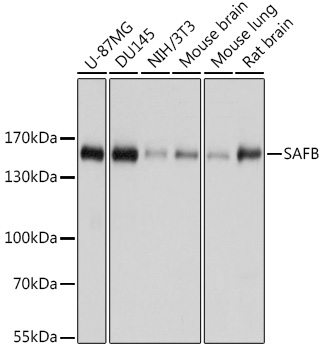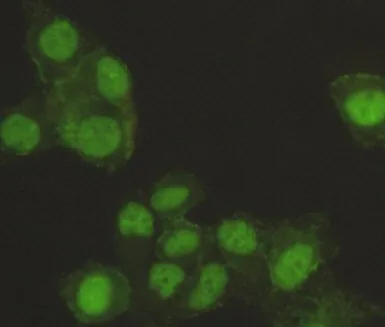![WB analysis of MCF-7 cell lysate using GTX18086 SAFB antibody [4i59]. Dilution : 0.5microg/ml WB analysis of MCF-7 cell lysate using GTX18086 SAFB antibody [4i59]. Dilution : 0.5microg/ml](https://www.genetex.com/upload/website/prouct_img/normal/GTX18086/GTX18086_20191203_WB_63_w_23060620_318.webp)
WB analysis of MCF-7 cell lysate using GTX18086 SAFB antibody [4i59]. Dilution : 0.5microg/ml
SAFB antibody [4i59]
GTX18086
ApplicationsImmunoFluorescence, ImmunoPrecipitation, Western Blot, ImmunoCytoChemistry, ImmunoHistoChemistry, ImmunoHistoChemistry Paraffin
Product group Antibodies
ReactivityHuman
TargetSAFB
Overview
- SupplierGeneTex
- Product NameSAFB antibody [4i59]
- Delivery Days Customer9
- Application Supplier NoteWB: 0.5microg/ml. *Optimal dilutions/concentrations should be determined by the researcher.Not tested in other applications.
- ApplicationsImmunoFluorescence, ImmunoPrecipitation, Western Blot, ImmunoCytoChemistry, ImmunoHistoChemistry, ImmunoHistoChemistry Paraffin
- CertificationResearch Use Only
- ClonalityMonoclonal
- Clone ID4i59
- ConjugateUnconjugated
- Gene ID6294
- Target nameSAFB
- Target descriptionscaffold attachment factor B
- Target synonymsHAP, HET, SAB-B1, SAF-B, SAF-B1, SAFB1, scaffold attachment factor B1, HSP27 ERE-TATA-binding protein, HSP27 estrogen response element-TATA box-binding protein, Hsp27 ERE-TATA binding protein, glutathione S-transferase fusion protein, heat-shock protein (HSP27) estrogen response element and TATA box-binding protein
- HostMouse
- IsotypeIgG
- Protein IDQ15424
- Protein NameScaffold attachment factor B1
- Scientific DescriptionThis gene encodes a DNA-binding protein which has high specificity for scaffold or matrix attachment region DNA elements (S/MAR DNA). This protein is thought to be involved in attaching the base of chromatin loops to the nuclear matrix but there is conflicting evidence as to whether this protein is a component of chromatin or a nuclear matrix protein. Scaffold attachment factors are a specific subset of nuclear matrix proteins (NMP) that specifically bind to S/MAR. The encoded protein is thought to serve as a molecular base to assemble a transcriptosome complex in the vicinity of actively transcribed genes. It is involved in the regulation of heat shock protein 27 transcription, can act as an estrogen receptor co-repressor and is a candidate for breast tumorigenesis. This gene is arranged head-to-head with a similar gene whose product has the same functions. Multiple transcript variants encoding different isoforms have been found for this gene.[provided by RefSeq, Jan 2011]
- ReactivityHuman
- Storage Instruction-20°C or -80°C,2°C to 8°C
- UNSPSC12352203





